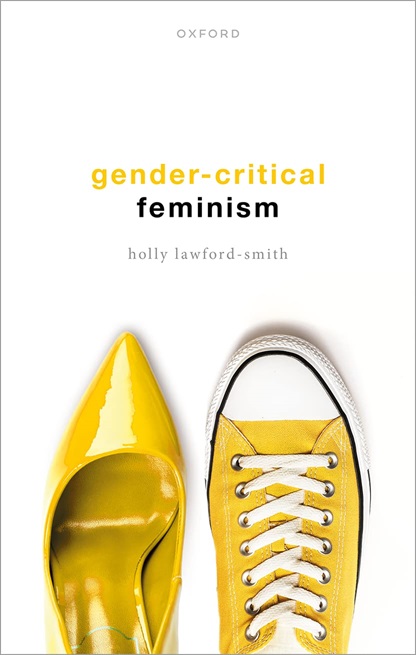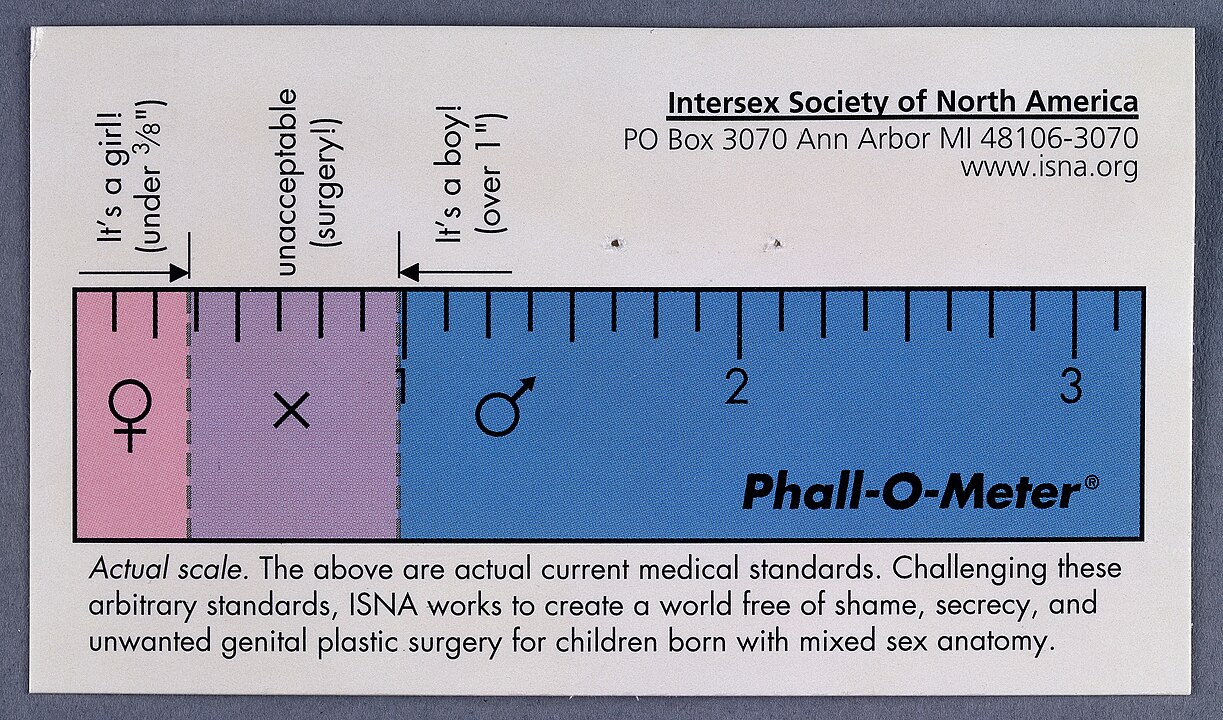Introduction
Holly Lawford-Smith’s 2022 book “Gender-Critical Feminism” attempts to outline a burgeoning movement with deep roots in radical feminism. She defines it in opposition to what she sees as the increasing deficiencies of a “liberal” and intersectional feminism that is overburdened by the competing demands of other minorities, and the input of men.

We are confident that Gender Critical Feminism offers a serious and rigorous academic representation of this school of feminist thought.
David Clark, Managing Director, Oxford University Press
The foundation of a new feminism
On the very first page Holly lays out the foundation for her new feminism:
I’ll use ‘male’ and ‘female’ in the standard way, to refer to the two biological sexes. The former is the sex that all going well produces small mobile gametes (sperm), the latter is the sex that all going well produces large immobile gametes (eggs).
(pg. 1)
Holly sees the important core of her feminism (its essence) to be the political organisation of women, for the advancement of women. To her, women are adult human females, and females produce large gametes (all going well). From here on out I’ll be referring to women as-defined-under-Holly’s-feminism as “gametta”, plural “gammetae”. Confusingly, Holly names this feminism “gender-critical feminism”. This focuses on something non-core to that feminism—a critique of gender—rather than its organising structure and constituency. In order to clearly distinguish Holly’s proposed form of feminism using its core belief, I will therefore be referring to this gamete-based feminism as “Gametism” from now on.
How does Gametism police gametes?
It may be that other related systems of organisation for feminism focus on different biological traits, like chromosomes, or hormone levels, or even outward appearance, and those systems will have to come to grips with what Holly has settled on here. There are organisations and commentators advocating for “XX” rights under the guise of feminism already, which demonstrates a problem with Gametism as a definition for even “gender-critical” feminism.
It is important that we understand the limits of Holly’s Gametism, and who is and isn’t welcome. Of particular interest is Holly’s use of the phrase “all going well” in reference to the production of gametes. We have very little information on what Holly means by this. She uses this phrase twice in her book, on the first page, and then never again. The phrase is itself so loaded and unclear that it demands interrogation.
One of the primary reasons this phrase is included is that it allows the assertion of a binary. The allies of Gametism will often refer to sperm and eggs as the differentiating characteristics of men and women. This is, however, already not a binary system, since producing sperm, producing eggs, and producing nothing are all options. Holly defends her binary construction by including the “all is well” phrase. This suggests that every person’s body is mappable to one of two options, which already comes with a couple underlying alarming suggestions:
The first is the idea that a body that isn’t producing gametes is one where all is not well. This unnecessarily relegates menopausal gamettae to a status of not being “well”. It is also true that there are bodies which will never produce gametes and for which “all is well”. Women can choose to have a hysterectomy and still be going well.
The second is that making the determination that all is well requires the participation of the medical establishment that the Gametists don’t trust with gender affirmation care. They are presumably happy to have that medical establishment determine what gametes will be produced, “all going well”, by each individual body. If the medical establishment is poisoned by the patriarchy, why trust it to determine womanhood?
Holly suggests that there are “significant harms” if gamettae don’t have access to feminism (pg. 103). Holly also believes that Gametism will fail if it doesn’t exclusively cater to gamettae. It is therefore critical that Gametism only welcomes gamettae. As far as I know, there isn’t a certification someone can get to prove they are a gametta. Many doctors still assign sex at birth on the basis of an external genital inspection, and write F on the birth certificate on that basis. In the vast majority of cases no further diagnostic tools are used.

This seems to suggest that since gamete production is the primary axis by which Holly wants her feminism organised, that the Gametists will need to affirm that their bodies produce large gametes or would if all was well. Without this affirmation, women can’t participate in feminism. I don’t believe that many women, and probably more to the point, many women who consider themselves feminists, know if they are gametta or not. As far as I can tell Holly places no requirement for medical proof of a person’s gametta status on inclusion into feminism, and allows them to self-identify into the category.
Exploring what diagnostic tests are involved in detecting gametta is also important. Holly doesn’t specify these, but there must be a test or series of tests for which the answer is either “large gametes” or “small gametes” in order for her binary to hold true. Which medical authority has produced the diagnostic criteria which detect gametta when no gametes are currently produced? Has Holly been tested? Is Holly potentially not a gametta, and ruining the Gametist project?
Given the definition of gametta and Holly’s assertion that they are the only true females, it is also unclear why at some points Holly seems to contradict herself:
For example, suppose I say ‘this person is male’, and then I am asked ‘how do you know?’ and I provide my reasons: ‘his physique, his facial features, the pitch of his voice.’
(pg. 129)
Under the Gametists definition, none of these traits are actually fundamentally at odds with a person being a gametta. None provide evidence that someone is a Gametist-male (gametto) either—unless these are some of the diagnostic tools doctors use to determine binary gamete production.
One of the surefire current low-tech ways someone can confirm that their body produces large gametes, is to have a child. Documentary evidence of this would seem to be the Gametist’s best bet at proving they are gametta. However, the ambiguity then of having two women on a birth certificate, something that Kathleen Stock recently wrestled with, would be at odds with this form of proof. In any case, having proof of being a gametta tied to nothing but childbirth is probably not something Holly wants. After all, gametta are not to be reduced to their capacity to have babies. The best proof is probably some medical documentation of gamete production, in order to keep the political project of the Gametists, pure.
When are women?
In her book, Holly provides the mainline Gametist theory about the origin of the patriarchy:
I have said at multiple points in this book that feminism is a political movement for women’s self-determination. I think it is crucially important that the androcentrism of human history, at least since the beginning of patriarchy some three and a half thousand years ago, has so deeply shaped the world we live in. Particularly, I am concerned with how men have created ideas about what a woman is, and what women are for, and how these ideas have served men’s needs particularly well by providing them with sexual and domestic service.
(pg. 196)
My interpretation of this statement is that women have existed under patriarchy for 3500-ish years, and during that time men have constructed norms surrounding the role of women. But here, of course, Holly is talking about gametta. Does talking about gametta make sense? The mammalian ovum was discovered by Karl Ernst von Baer in 1827. It is factually true to say then that gametta were only known to exist for less than two hundred years. This means that for around three millenia, women were oppressed under the patriarchy on the basis of something other than their status as gametta. It simply wasn’t possible for them to be oppressed on the basis of being gametta before the discovery of their gametes.
In terms of a political struggle, it is clear that to undo three millennia of patriarchy, those that were victims of it, ought to be included in its undoing. Currently, oppression rarely occurs as a direct result of someone knowing for sure whether someone is gametta or not. Women without access to the medical tools necessary to be confirmed as gametta and those that don’t know what gametes are, are still affected by the patriarchy. Holly claims that “sex is not socially constructed”, and that sex is found in the objective world “like rocks and trees” (pg. 42). But even if sex is intrinsic to the world, humans functioned without a scientific and biological understanding of sex for thousands of years. What’s socially constructed is Holly’s contemporary take on what it is to be a feminist. The oppression of women preceded that construction. To be sure, people do experience oppression on the basis of their biology. When people who menstruate don’t have access to hygienic products and when pregnant people have no place to safely give birth, they suffer oppression. Unfortunately, Gametists often oppose precise descriptions of biological processes like these descriptions. Women aren’t, as the Gametists claim, oppressed on the basis of being gametta, but on the basis of being women.
A clear question here is why ought feminism organise under the Gametist umbrella when it doesn’t address how the patriarchy oppressed and still oppresses women? Gametists medicalize the determination of womanhood in a way that most women and men don’t. It is possible for someone to be assigned female at birth, grow up socialised as a woman, suffer horrific violence and oppression by society on the basis of their womanhood, and then be barred from Holly’s feminism. For almost all of its history, women were oppressed by the patriarchy while the patriarchy had no knowledge of gametes. Why would Gametism liberate women now?
There is no scientific evidence to suggest that feminists need to produce large gametes, all going well, in order to effectively take down the patriarchy. There’s no test Holly can suggest to test that hypothesis. There’s no test she can run to show that the oppression of women today and in the past is on the basis of gamete production. The social oppression of women doesn’t require the presence of gametes.
Holly’s feminism is ahistorical, unscientific, and trans exclusionary.
Next in this series of articles, we’ll dig into Holly’s interpretations and responses to intersectionality, and her rejection of what she sees as “burdens” to Gametism.
